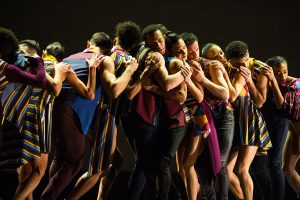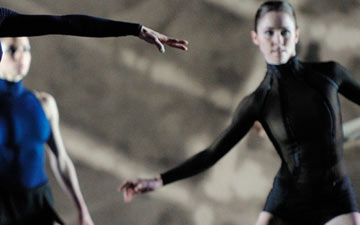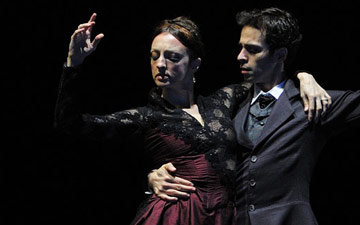
© Tim Russell. (Click image for larger version)
GERALDCASELDANCE
Cover Your Mouth When You Smile, Thirdperson, Fluster
★★★✰✰
San Francisco, ODC Theater
8 December 2016
www.geraldcasel.com
odcdance.org
Evaluating works in progress is a peculiar exercise. Without knowing what parts of a dance are complete or still conceptual, or where they fit within the context of a larger yet to be created piece (something the choreographer may not know, either), a review is a guessing game.
So it’s with a measure of pause that I’m weighing in on Gerald Casel Dance’s fall home season, which premiered Thursday, Dec. 8, at ODC Theater in San Francisco. Casel is a Bessie Award–winning former dancer with Stephen Petronio and Lar Lubovitch, professor of dance and longtime postmodern dance maker; he is on a three-year residency at ODC.
Two of the three works Casel presented, Cover Your Mouth When You Smile and Thirdperson, were previews of dances in progress; the third, Fluster, was commissioned by Danspace Project at St. Mark’s Church in New York City and premiered there in 2010.
Self-silencing hand gestures recur in Cover Your Mouth, a duet Casel performed with co-creator Na-ye Kim. In their artist statement, Casel, who was born in the Philippines, and Kim, who was born in Korea and teaches in Hong Kong, cite “racial melancholia, the model minority myth, and mimicry in Asian and Asian-American cultures” as their starting points for the work; mimicry appears in twinned and mirrored phrases that triggered interactive, abstract video projections by Aron Altmark on the back wall. Mostly what is visible in the 10-minute snippet is restraint and clarity of gesture, loping rhythms that emphasize a low center of gravity, and Casel’s expertise at shaping the vastness of a black box into an enveloping space for two dancers.
Similar compositional themes arise in Thirdperson, but are extrapolated to a four-woman, one-man ensemble. Arletta Anderson, Kristen Bell, Christina Briggs-Winslow, Rebecca Chaleff and Kevin Lopez are vibrant movers, making Thirdperson as dynamic as Cover Your Mouth was restrained. These five different minds and bodies impose new dimensions on Casel’s choreography, which seems to operate on multiple planes at once. Anderson’s torso and lower body seem able to articulate independently of each other; Chaleff’s extreme turnout takes repeated fourth-position lunges to their furthest limits.
The quintet is in continuous motion, forming twos, threes and solos, and pausing periodically to observe one another. Casel’s transitions are seamless; combined with the dancers’ colorful street clothes, the flow creates a terrific kaleidoscopic illusion – blink and you’ll miss a tableaux vivant. Running in circles seems cliché when it pops up in the middle of all this originality, but for all we know it’s a work-in-progress experiment that will manifest in some other way, or make a different kind of sense, in the completed piece.

© Tim Russell. (Click image for larger version)
The revival of Fluster hints at what may lie ahead for the other two works. The original cast reunited to dance it, with Casel alongside Nicholas Strafaccia and Samuel Wentz, former students of his who went on to join the Trisha Brown Dance Company. Stage mist and low lighting correspond to the murkiness of their interrelationship – what are they flustered about? – and the dancers’ flat affects divulge no clues.
One gleans from their movement what one will: synchrony versus dissonance, pauses versus flashes of speed and elevation. Rather than narrative, gestures without referents channel virtuosity, and sometimes very subtly, as when Wentz posed downstage in an extended balance on one foot. He held the other foot alongside, just an inch off the ground, and swung it in loose dégagés, a deceptively simple-looking maneuver that caused dynamic misalignment in his body and a crackling suspense in the air.
Altmark’s lighting schemes created rich visual fields for each work. Between bowing metal vessels, playing a drum kit with his hands and mixing digital sound samples, Tim Russell’s live musical accompaniment was a thrilling show within the show.

















You must be logged in to post a comment.